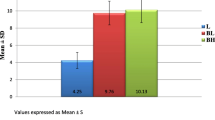Abstract
Purpose
The aim of this study was to assess whether addition of epineural buprenorphine prolonged postoperative analgesia of middle interscalene brachial plexus block (MIB) with levobupivacaine.
Methods
One hundred and fifty consenting adult patients, scheduled for shoulder arthroscopic surgery for a rotator cuff tear under MIB with 29.5 ml of 0.75 % levobupivacaine, were randomized to receive additionally either saline or intramuscular buprenorphine 0.15 mg or epineural buprenorphine 0.15 mg. Onset of sensory and motor blocks, duration of postoperative analgesia, and consumption of postoperative analgesics were compared among the groups.
Results
There were significant (P < 0.05) differences in the onset and the duration of the sensory block and in the duration of postoperative analgesia. Duration of both sensory block and postoperative analgesia was longer (P < 0.05) in patients who had received epineural buprenorphine (856.1 ± 215.2 and 1,049.7 ± 242.2 min) than in patients who had received intramuscular buprenorphine (693.6 ± 143.4 and 820.3 ± 335.3 min) or saline (488.3 ± 137.6 and 637.5 ± 72.1 min). Requirement of postoperative rescue analgesics was lower in the epineural buprenorphine group than in the other two groups. Few complications occurred from MIB (<1 %) and none from buprenorphine.
Conclusions
Epineural buprenorphine prolonged postoperative analgesia of MIB more effectively than intramuscular buprenorphine, which suggests that buprenorphine acts at a peripheral nervous system site of action.

Similar content being viewed by others
References
Hall RJ. Hydrochlorate of cocaine. N Y Med J. 1884;40:643–6.
Neal JM, Kopacz DJ, Liguori GA, Beckman JD, Hargett MJ. The training and careers of regional anesthesia fellows: 1983–2002. Reg Anesth Pain Med. 2005;30:226–32.
Alemanno F. A novel approach to brachial plexus. Minerva Anestesiol. 1992;58:403–6.
Alemanno F, Gretter R, Di Leo Y, Bellini L. Alemanno’s brachial plexus block ten years later: topographic study of the anesthetised areas. Minerva Anestesiol. 2003;69:575–81.
Alemanno F, Capozzoli G, Egarter-Vigl E, Gottin L, Bartoloni A. The middle interscalene block: cadaver study and clinical assessment. Reg Anesth Pain Med. 2006;31:563–8.
Foster RH, Markham A. Levobupivacaine: a review of its pharmacology and use as a local anaesthetic. Drugs. 2000;59:551–79.
Candido KD, Franco CF, Khan MA, Winnie AP, Raja D. Buprenorphine added to the local anesthetic for brachial plexus block to provide postoperative analgesia in outpatients. Reg Anesth Pain Med. 2001;26:167–72.
Candido KD, Winnie AP, Ghaleb AH, Fattouh MW, Franco CD. Buprenorphine added to the local anesthetic for axillary brachial plexus block prolongs postoperative analgesia. Reg Anesth Pain Med. 2002;27:162–7.
Axelsson K, Gupta A. Local anaesthetic adjuvants: neuraxial versus peripheral nerve block. Curr Opin Anaesthesiol. 2009;22:649–54.
Carstens E, Tulloch I, Zieglgänsberger W, Zimmermann M. Presynaptic excitability changes induced by morphine in single cutaneous afferent C- and A-fibers. Pflugers Arch. 1979;379:143–7.
Murphy DB, McCartney CJ, Chan VW. Novel analgesic adjuncts for brachial plexus block: a systematic review. Anesth Analg. 2000;90:1122–8.
Candido KD, Hennes J, Gonzalez S, Mikat-Stevens M, Pinzur M, Vasic V, Knezevic NN. Buprenorphine enhances and prolongs the postoperative analgesic effect of bupivacaine in patients receiving infragluteal sciatic nerve block. Anesthesiology. 2010;113:1419–26.
Kabirullah L, Cowan A. Buprenorphine: a unique drug with complex pharmacology. Curr Neuropharmacol. 2004;2:395–402.
Kabirullah L. Buprenorphine-induced antinociception is mediated by mu-opioid receptors and compromised by concomitant activation of opioid receptor-like receptors. J Neurosci. 2003;23:10331–7.
Gobeaux D, Landais A. Utilisation de deux morphiniques dans le bloc du plexus brachial. Cah Anesthesiol. 1988;36:437–40.
Viel EJ, Eledjam JJ, de la Coussaye JE, D’Athis F. Brachial plexus block with opioids for postoperative pain relief: comparison between buprenorphine and morphine. Reg Anesth Pain Med. 1989;14:274–8.
Esmaoglu A, Yegenoglu F, Akin A, Turk CY. Dexmedetomidine added to levobupivacaine prolongs axillary brachial plexus block. Anesth Analg. 2010;111:1548–51.
Piangatelli C, De Angelis C, Pecora L, Recanatini F, Cerchiara P, Testasecca D. Levobupivacaine and ropivacaine in the infraclavicular brachial plexus block. Minerva Anestesiol. 2006;72:217–21.
Liisanantti O, Luukkonen J, Rosenberg PH. High-dose bupivacaine, levobupivacaine and ropivacaine in axillary brachial plexus block. Acta Anaesthesiol Scand. 2004;48:601–6.
Borgeat A, Ekatodramis G, Blumenthal S. Interscalene brachial plexus anesthesia with ropivacaine 5 mg/mL and bupivacaine 5 mg/mL: effects on electrocardiogram. Reg Anesth Pain Med. 2004;29:557–63.
Pick CG, Peter Y, Schreiber S, Weizman R. Pharmacological characterization of buprenorphine, a mixed agonist-antagonist with kappa 3 analgesia. Brain Res. 1997;744:41–6.
Brull R, McCartney CJ, Chan VW, El-Beheiry H. Neurological complications after regional anesthesia: contemporary estimates of risk. Anesth Analg. 2007;104:965–74.
Acknowledgments
This study was supported only by departmental funds.
Author information
Authors and Affiliations
Corresponding author
About this article
Cite this article
Behr, A., Freo, U., Ori, C. et al. Buprenorphine added to levobupivacaine enhances postoperative analgesia of middle interscalene brachial plexus block. J Anesth 26, 746–751 (2012). https://doi.org/10.1007/s00540-012-1416-4
Received:
Accepted:
Published:
Issue Date:
DOI: https://doi.org/10.1007/s00540-012-1416-4




